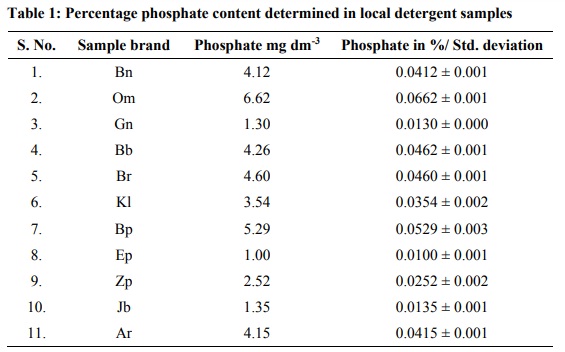Determining the amount of phosphate in detergents
Abstract
In this experiment you will analyze a detergent for phosphate and compare your result with the value on the label. If you have some detergent at home that you would like to analyze, bring about 5 grams to lab. Record the name of the detergent, the amount of phosphate or phosphorus indicated on the label, the recommended amount for a load of wash. With this information we can determine which detergent analyzes for the highest and lowest phosphate (or phosphorus) levels and which uses the most and least phosphate (or phosphorus) per load.
Most of the chemicals used in this experiment can be put down the drain. However, the color developed solutions contain the heavy metals, vanadium and molybdenum. Be sure to put them in the aqueous waste container, as directed by your instructor.
Introduction
Phosphorus is the eleventh most abundant element on the surface of the earth and is most commonly found as phosphate. In nature, phosphate rocks include fluoroapatite, 3Ca3(PO4).CaF2, chloroapatite, 2Ca3(PO4).CaCl2 and hydroxyapatite, 3Ca3(PO4)2.Ca(OH)2, calcium iron phosphate Ca2Fe(PO4).4H2O. Fluoroapatite, 3Ca3(PO4).CaF2 is the chief ore of phosphorus. The phosphorus is removed from the ore by first grinding it to remove large lumps, and then heating it in a mixture with sand (silica, SiO2) and coke (carbon). The reactions take place at around 1500o C using an electric arc furnace. The key reaction is –
2Ca3(PO4) 2 + 6SiO2 + 10C ⎯⎯→ 6CaSiO3 + 10CO + P4
The product, which is white can be converted into red phosphorus by heating at 400o C for some hours1 . Phosphates are added to detergents as builders in the form of sodium tripolyphosphate and sodium pyrophosphate. The excessive use of phosphate as water softeners is criticized by environmentalists, since it contributes to water pollution. The phosphates in domestic waste water pass through sewage disposal systems into rivers and lakes. There they nourish bacteria, which grow excessively and deplete the water of dissolved oxygen, thus killing fish. The phosphates may also produce massive overgrowth of water plants. When this crop of plant dies, there will be excessive decay and putrefaction, which may also kill the fish.
In addition, excessive phosphates are known to accelerate the natural aging of lakes (eutrophication). They enter water ways as run off from agricultural lands as fertilizer and as human and animal waste. The largest source of phosphorus entering the environment is synthetic detergent, which contains phosphate compounds to soften water, increase the pH of water, and increase surfactant efficiency. In the mid 1960s, many of the nations’ rivers and lakes were rapidly turning green and choking with aquatic plant growth. It was later observed that the primary reason for these deleterious changes in water quality was the high levels of phosphorus, one of the several major plant nutrients, found in domestic and municipal sewage effluents.
The principal source of effluent phosphorus was from phosphates used in laundry detergents . The general feeling around the late 1960s was that many nations’ lakes and streams were getting more polluted each day, and phosphate detergents were the primary reason. Half the phosphorus input to lakes Erie and Ontario came from municipal and industrial sources of which 50% to 70% came from detergents. Over half of the phosphorus input to the Potomac estuary also came from detergents in municipal and industrial effluents . It was generally agreed that detergents accounted for about 50% of the waste water nationwide
Detergent is an substance, which has the ability to clean an object. A detergent may be regarded as a surface active agent (surfactant) particularly effective in dislodging foreign matter from soiled surfaces and retaining it in suspension. The term usually denotes a synthetic substance that is not prepared by saponifying fats and oils5 . The most important advantage of the synthetic detergents is better wetting and cleansing action and no consumption by hard water because of higher solubility of their Ca2+ and Mg2+ ions6 .
Phosphorus, which is an important plant nutrient, occurs widely in the environment and in the aqueous environment the phosphorus greatly encourages microbial growth which is undesirable. The determination of phosphorus is therefore of importance to chemical analysts and limnologists. Detergents, sewage and fertilizers are known to be the major sources of phosphorus and the level of 0.03-0.40 mg dm-3 of total inorganic phosphate had become the maximum acceptable level in water.
Procedure
•Preparation of the Detergent Sample:
Color Development
The Analysis of the Solutions
Results And Discussion
On estimating the phosphate concentrations in each detergent samples from both local and foreign brands, it was discovered that there were inconsistent variations in the phosphates levels from one company to another and from country to country. The phosphate levels in the locally available detergents ranged between 0.0100 ± 0.001-0.0662 ± 0.001 and those of foreign detergents ranged between 0.0047 ± 0.001-0.0305 ± 0.000. A critical examination of Table 1 and 2 revealed that local detergents like Om, Bb, Br, Bp, and Ar with percentage phosphate content corresponding to 0.0662%, 0.0462%, 0.0460%, 0.0529% and 0.0415%, respectively have a higher phosphate content than the foreign ones like Ps, Td, Lk, Ta, Dm, Bg, Bs, Kn, and Lb having percentage phosphate content corresponding to 0.00473%, 0.0423%, 0.0272%, 0.00680%, 0.00491%, 0.0255%, 0.0305% and 0.0064%, respectively






0 Comments